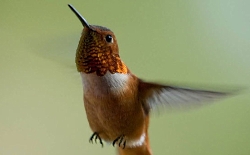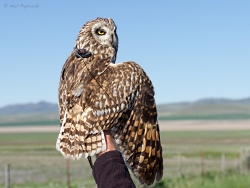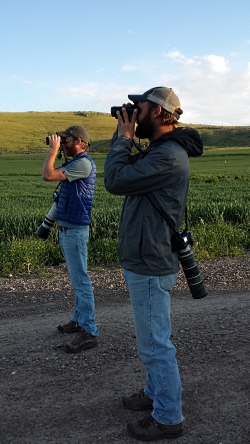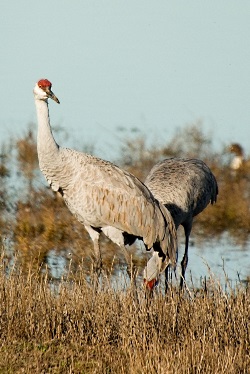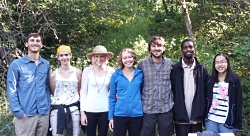
Kyle Mika, Jennifer Bridgeman, Kylynn Clare, Anna Vickrey, JJ Horns, Ahmed Bwika, and Patricia Gao.
Courtesy & Copyright Jessie Bunkley, Photographer
[Sound of walking on gravel]
J.J. Horns – Our lab name is the Biodiversity and Conservation Ecology lab and our work focuses on how human land use affects different types of wildlife.
J.J. – I’m J.J. Horns.
Patricia Gao – I’m Patricia.
Ahmed Bwika – I’m Ahmed.
Anna Vickrey – I’m Anna Vickrey.
Kyle Mika – I’m Kyle Mika.
Jennifer Bridgeman – I’m Jennifer Bridgeman.
Kylynn Clare – I’m Kylynn Clare.
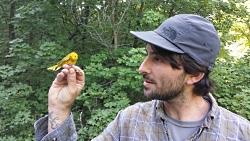
Courtesy & Copyright Jessie Bunkley, Photographer
J.J. – Here in Red Butte Canyon we monitor migratory songbirds as they move through and try and get a picture of one, what is the bird community like in Utah. That’s why Red Butte Canyon is such a nice place to work because it’s a protected canyon so it gives an idea of what the natural state of birds along the Wasatch should be like. And we monitor their populations, look for any population level changes, and we look for changes in their migration, in the health of the birds, and try and understand how human effects like land development and climate change are affecting these bird communities.
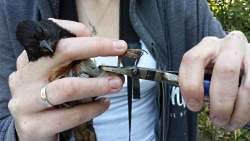
Courtesy & Copyright Jessie Bunkley, Photographer
Ok, so we’re ready to go around and check our nets.
Anna – The mist net is this really superfine, hard to see material with shelves in it. So when the bird flies into the net it kind of falls into one of these net shelves and that material is so fine, especially if you put it in front of a tree, that the birds don’t see it and so they’ll just fly right into it, fall in, and we come around frequently enough that they’re not in there for a long time.
J.J. – So this is a bird called a spotted towhee and based on how brown that head is
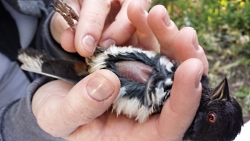
Courtesy & Copyright Jessie Bunkley, Photographer
Anna – And the eye color, right?
J.J. – and the eye color, we can tell that it’s a little baby, just born this year. Towhee squawking in the background. When the bird lands in the net like this they get all tangled up, they get the net around their wings and around their legs, and so what we do is we carefully take it off of any part of their body where it’s tangled up and then we put them in these little bird bags. And the bird bags are just little cloth sacks that keep the bird warm and because they’re kind of dark the bird stays really calm.
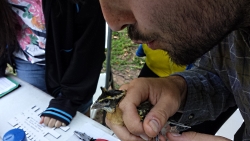
Courtesy & Copyright Jessie Bunkley, Photographer
Jennifer – It’s a baby yellow warbler!
Kylynn – Spotted towhee.
J.J. – Black-headed grosbeak.
Mourning dove.
Kyle – Song sparrow.
J.J. – So this is a yellow warbler. So as part of the banding we take the age and the sex and then a bunch of morphological measurements. We can tell this one’s a male by those brown streaks on the breast and we can also tell it is an older bird. It’s been around for at least one year because of that nice yellow edging on those tiny feathers there.
[Sound of JJ blowing the bird’s feathers away from its body.]
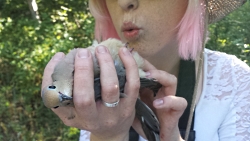
Courtesy & Copyright Jessie Bunkley, Photographer
Let’s say a CP of one. A CP is a cloacal protrusion, it’s what males get when they’re breeding. Sound of blowing. No brood patch. Brood patches are where birds will loose feathers on their stomachs so they can incubate eggs. Sound of blowing. No fat. Birds deposit fat in a really predictable way. They have a little cavity where their collar bone is. Sound of blowing. No body molts. Not growing any feathers on his body. Wing is sixty-two and his weight is 8.4.
If anyone is interested in helping out bird conservation just in their day to day life, if you have cats either keep them inside or buy them a cat bib or a couple of bell collars. That’s probably the number one thing you can do to help bird conservation.
Everyone – For Wild About Utah this is the Şekercioğlu lab in Red Butte Canyon!

